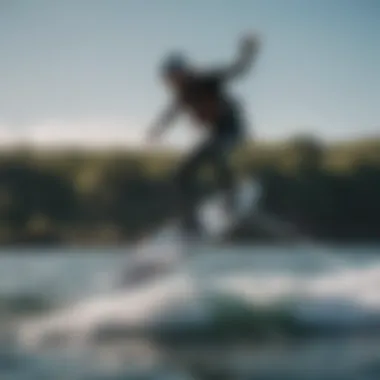Unlocking the Ingenious Mechanics of Foil Boards: An In-Depth Analysis


Equipment Reviews
To kickstart our exploration of foil boards, we first need to delve into the fundamental component - the kite. A pivotal aspect of kitesurfing and kiteboarding, kites come in a variety of shapes, sizes, and materials, each influencing performance and handling differently. From delta kites to hybrid models, the design of a kite affects its maneuverability and power delivery, impacting the overall riding experience. Brands play a crucial role in the kite market, with industry leaders innovating to enhance stability, wind range, and responsiveness in their models. By understanding the intricacies of kite shapes, sizes, materials, and prevalent brands, riders can make informed decisions that align with their riding style and skill level.
Moving on to boards, they are the backbone of a rider's experience on the water. Twin tip boards and directional boards cater to contrasting riding styles and conditions, with design and construction directly influencing performance. Twin tips offer versatility and easy maneuverability, ideal for freestyle tricks and jumps, while directional boards excel in wave riding and carving. Construction materials like carbon fiber, wood, and foam determine a board's durability, flex, and weight, impacting control and responsiveness. Choosing the right board that aligns with riding style, skill level, and water conditions is paramount for optimizing the foil boarding experience.
Furthermore, accessories play a vital role in ensuring a safe and enjoyable kiteboarding session. Harnesses, lines, pumps, and safety gear are instrumental in enhancing comfort, control, and safety on the water. Harnesses distribute the pull of the kite evenly, reducing strain on the body during powered maneuvers. Quality lines are essential for stability and responsiveness, while efficient pumps ensure quick and hassle-free kite inflation. Safety gear like helmets, impact vests, and emergency release systems can prevent injuries and mishaps, underscoring their importance in every rider's kit. By examining the significance of each accessory and their impact on performance and safety, riders can enhance their overall foil boarding experience.
Understanding Foil Boards
Foil boards are at the forefront of innovation in kitesurfing and kiteboarding, revolutionizing the riding experience on the water. They represent a blend of cutting-edge hydrodynamic and aerodynamic principles that challenge traditional board designs. Understanding the intricacies of foil boards is crucial for enthusiasts aiming to enhance their performance and maneuverability on the water.
The Basics of Foil Boards
Introduction to Foil Boards
In the realm of watersports, the introduction of foil boards marks a significant shift in design philosophy. These boards incorporate a hydrofoil - a wing-like structure - underneath the board's surface, enabling riders to lift above the water and minimize drag. This innovation is particularly advantageous for riders seeking heightened speed and agility, as it reduces the contact area with the water, resulting in smoother glides and improved control. Despite their advantages, beginners may find the learning curve steep due to the increased sensitivity and adjustments required while riding on the foil.
Components of a Foil Board
A crucial aspect of foil boards lies in their components, each playing a vital role in the board's overall functionality. From the fuselage to the mast and wings, every part is meticulously designed to optimize lift and stability on the water. The fuselage serves as the connection between the wings and the board, ensuring proper weight distribution and balance. Masts come in various lengths, offering riders customization options based on their riding style and skill level. Wings, the most distinctive element, vary in shape and size, influencing lift, speed, and turning capabilities. Understanding these components is fundamental to selecting a foil board that aligns with individual preferences and riding goals.
Evolution of Foil Board Design


The evolution of foil board design showcases a progressive shift towards enhanced performance and versatility. Over the years, designers have focused on refining hydrofoil shapes, materials, and compatibility with different board styles. Advanced manufacturing techniques have led to lighter, stronger foils that deliver optimal efficiency and control on the water. Riders now have access to a diverse range of foil designs, each tailored to specific riding conditions and skill levels. As technology advances, the future of foil board design holds exciting prospects for further innovation and precision in performance.
Hydrodynamics of Foil Boards
Lift and Drag Forces
Riding Techniques with Foil Boards
In the comprehensive guide on decoding the mechanics of foil boards, the section concerning riding techniques is of utmost importance. Riding techniques play a critical role in maximizing the performance and efficiency of foil boards in kitesurfing and kiteboarding. By mastering the art of foiling, riders can significantly enhance their experience on the water. This section delves into the specific elements, benefits, and considerations related to riding techniques with foil boards.
Mastering the Art of Foiling
Balancing on the Foil
When it comes to foiling, balancing on the foil is a fundamental aspect that dictates the rider's stability and control over the board. The key characteristic of balancing on the foil lies in maintaining a harmonious equilibrium between the rider's weight distribution and the foil's lift. This balance is crucial as it determines the rider's ability to maneuver effectively on the water. Balancing on the foil is a popular choice for this article due to its direct impact on the rider's overall performance and safety. The unique feature of balancing on the foil is its responsiveness to subtle weight shifts, giving riders precise control over their movements. However, mastering this skill requires practice and patience as it can be challenging for beginners.
Initiating Turns and Carves
Initiating turns and carves is another essential aspect of foiling that adds dynamism and fluidity to the rider's experience. This technique enables riders to change directions smoothly and execute sharp maneuvers with precision. The key characteristic of initiating turns and carves is the ability to use weight shifts and foil manipulation to carve tight arcs and navigate swiftly through the water. This technique is a popular choice for this article as it enhances the rider's agility and responsiveness on the foil board. The unique feature of initiating turns and carves is its influence on the rider's creativity in exploring diverse riding styles and adapting to different conditions. However, mastering this technique necessitates coordination and practice to execute seamless turns.
Optimizing Take-Off and Landing
Optimizing take-off and landing is a crucial aspect of foiling that ensures a smooth initiation and completion of rides. The key characteristic of optimizing take-off and landing lies in achieving a balance between the rider's speed, angle of attack, and foil positioning during lift-off and touchdown. This optimization is vital as it determines the efficiency and stability of the rider throughout the ride. Optimizing take-off and landing is a beneficial choice for this article as it promotes safe and controlled riding experiences. The unique feature of optimizing take-off and landing is its contribution to reducing drag and enhancing the rider's aerial transitions. However, mastering this aspect requires precise timing and technique to achieve seamless take-offs and landings.


Maintenance and Care Tips for Foil Boards
Maintenance and care tips for foil boards are crucial to ensure optimal performance and longevity of these specialized water sports equipment. Proper maintenance not only enhances the durability of foil boards but also contributes to a safe and enjoyable riding experience on the water. By adhering to recommended cleaning and storage practices, riders can prevent damage, extend the lifespan of their foil boards, and maintain peak performance levels.
Cleaning and Storage Practices
Rinsing After Use
Rinsing foil boards after each use is a fundamental practice in preserving their structural integrity and performance efficiency. By removing salt, sand, and debris from the foil board surface, riders prevent corrosion, maintain hydrodynamics, and uphold the aesthetic appeal of their equipment. Additionally, rinsing helps in preventing premature wear and tear, ensuring the foil board's components remain in optimal condition for prolonged use.
Rinsing after use is essential to prevent salt buildup, which can corrode metal components and compromise the foil board's overall functionality. It is a simple yet effective step that riders can take to prolong the lifespan of their foil boards and retain their riding quality.
Drying and Lubrication
Proper drying and lubrication of foil boards after rinsing play a vital role in preventing moisture-related damage and preserving structural integrity. By ensuring thorough drying, riders minimize the risk of mold or mildew growth, which can affect the materials and compromise performance. Lubricating critical components such as connection points and moving parts reduces friction, extends operational efficiency, and prevents premature wear.
Drying and lubrication are essential post-cleaning steps that contribute to the overall maintenance and care of foil boards. These practices not only enhance the longevity of the equipment but also improve operational smoothness and reliability during rides.
Safe Transportation Methods
When transporting foil boards, utilizing safe and secure methods is paramount to prevent accidental damage and ensure the equipment's safety during transit. Properly securing the foil board with padded covers or protective cases shields it from impacts and scratches, maintaining its structural integrity. Additionally, avoiding exposure to extreme temperatures and securing the board in a stable position minimizes the risk of transportation-related damage.
Employing safe transportation methods safeguards the foil board from potential harm while traveling to and from riding locations, helping riders preserve their equipment's condition and performance quality.


Choosing the Right Foil Board Setup
In the realm of foil boards, selecting the ideal setup is a pivotal decision that can significantly impact one's riding experience. The proper choice of foil board setup is paramount for maximizing performance and enjoyment on the water. Each component, from the foil size to the mast length, plays a vital role in the overall functionality and handling of the board. Riders must carefully consider their preferences, skills, and riding style to ensure they align perfectly with their chosen foil board setup.
Matching Foils to Riding Style
Selecting the Appropriate Foil Size
When it comes to selecting the appropriate foil size, riders delve into crucial considerations that directly influence their on-water performance. The foil size dictates the lift generated and impacts maneuverability, speed, and stability. Choosing the right foil size is essential for balancing control and agility while zipping across the water's surface. Riders must assess their proficiency level and riding goals to match the foil size that best complements their style and aspirations.
Finding the Ideal Mast Length
Finding the ideal mast length is a nuanced process requiring attention to detail and precision. The mast length directly influences the height at which the foil rides beneath the board, affecting stability and control. Riders often opt for specific mast lengths based on their comfort levels with varying heights and their desired riding experience. Fine-tuning the mast length ensures optimal performance and enhances the rider's ability to navigate turns and master maneuvers effortlessly.
Customizing Foil Configurations
Customizing foil configurations allows riders to tailor their equipment to meet their unique preferences and riding demands. Whether adjusting the wing's angle of attack or modifying fuselage lengths, customization empowers riders to optimize their foil setup for peak performance. By experimenting with different configurations, riders can fine-tune their foiling experience, enhancing speed, control, and overall enjoyment on the water.
Factors Influencing Foil Board Selection
Skill Level and Experience
The rider's skill level and experience serve as fundamental factors in determining the most suitable foil board setup. Novice riders benefit from user-friendly foils that prioritize stability and ease of control, while advanced riders may seek high-performance setups that offer enhanced agility and speed. Matching the foil board setup to the rider's proficiency level ensures a seamless transition into foiling and fosters continued progression and skill refinement.
Water Conditions and Terrain
Water conditions and terrain significantly impact the choice of foil board setup, influencing stability, speed, and overall ride comfort. Riders must consider factors such as wave height, wind strength, and water depth when selecting their foil setup to optimize performance and ensure a safe and enjoyable riding experience. Adapting the foil board setup to the specific demands of varying water conditions empowers riders to conquer diverse environments and explore new horizons in foiling.
Future Progression Considerations
Anticipating future progression is key when choosing a foil board setup, as riders often seek equipment that can evolve with their skills and ambitions. Investing in a setup that allows for adjustments and upgrades facilitates skill development and opens up possibilities for tackling advanced maneuvers and conditions. Considering future progression ensures that riders remain engaged and challenged, continually pushing their boundaries and expanding their foiling capabilities.







